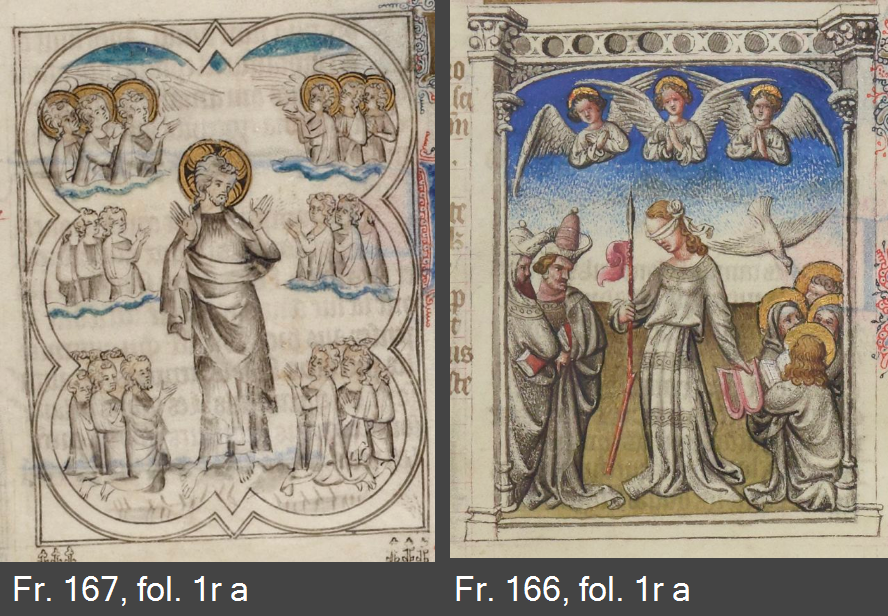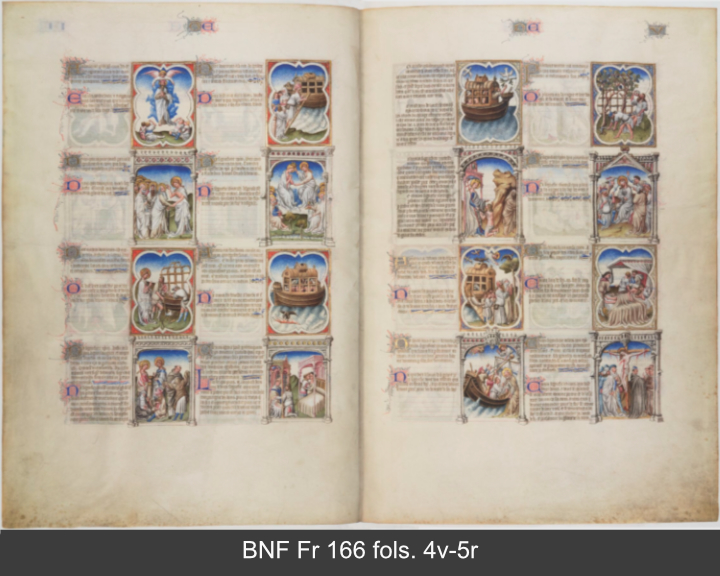2 Bibles Moralisées
BNF Fr167 & Fr166
Two Bibles Moralisées
“What is the meaning of the Bible?” The Bible Moralisée seeks to provide a comprehensive answer to this question. In order to do so, these heavily illustrated Bibles, the earliest of which dates to the first quarter of the thirteenth century, present each episode of the Bible along with accompanying moralized interpretations.
A detailed description of these works is presented by John Lowden in his two-volume study on the Making of the Bibles Moralisées (Penn State University Press, 2000). According to Lowden, only seven copies of this work survive today. The two manuscripts featured on this site are the latest copies and are both found in the Bibliothèque Nationale de France: manuscripts Fr. 167, dating from the end of the fourteenth century, and Fr. 166, which dates to the beginning of the fifteenth century. Lowden provides a detailed examination of each of these manuscripts in his first volume, pages 221-250 and 251-284 respectively.
Both manuscripts are organized in the following way. Each page is divided into four sections. Each section contains two illustrations—the first of which depicts a scene from the Bible (ABCD); the second depicts the interpretation of that scene (abcd). Both images have short captions written in both Latin and Middle French.
![]()
Since no two copies of the Bible Moralisée are identical, it is interesting to examine the differences between them. Already in the first group from the two manuscripts studied here, the text is expanded in the later version and the illustration is modified accordingly.
For folio 1r, group A, Fr. 167 reads: "In the beginning, God created the heavens and the Earth, and God said, 'Let there be light' and thus the light was made." Fr. 166 appends an additional phrase: "For the Earth was vain and empty and darkness was over the face of the gulf and the Spirit of God was over the waters."
In the interpretation of the scene (1r, group a), both manuscripts begin with: "The creation of light brought about the creation of angels, for they have an understanding of light." The later manuscript also adds: "and the Earth which is empty and dark represents the dark understanding of the prophets in the time of Synagogia, and the Spirit of God over the waters signifies the Holy Ghost given to the Apostles on the Day of Pentecost." Accordingly, Fr. 167 depicts God surrounded by concourses of angels, but Fr. 166 additionally features the traditional personification of Synagogia, blindfolded, with the plates of Moses in one hand, and a broken spear in the other. Old Testament prophets stand to her right and behind her, the Apostles receive the Holy Ghost in the form of a dove.

The stylistic difference in the illuminations of these two Bibles also merits attention. For example, the side-by-side presentation of the two manuscripts offers an exceptional opportunity to compare the work of the anonymous masters of Fr. 167 which served as a model for Paul and Jean de Limbourg, who completed most of the miniatures of Fr. 166, fols 1r-32v.
The comparison of any two of the Bibles Moralisées bears fruit. These two manuscripts were selected for comparison in particular because (1) they represent the end of the tradition; (2) because of the direct relationship of the earlier manuscript serving as the model for the later; (3) because Fr. 167 is the longest and most complete representation of the Bible of any of the other Bibles Moralisées; (4) because of the accessibility of the images via IIIF API. Note that the two manuscripts collate extremely closely, but that Fr. 166 is incomplete and stops in the middle of the Book of Isaiah.
The images on this site are all maintained and served directly from the resources of the Bibliothèque Nationale de France (BNF) as made available through Gallica.bnf.fr. The images are cropped and presented using the API of the International Image Interoperability Framework (IIIF) which these institutions have generously adopted. Permission for the re-use of these images can be granted only under the terms of Gallica and the BNF.
The core data of image coordinates for this collection is now available in two JSON files on GitHub, Parsing the Bible Moralisée (https://github.com/toisondor/parsing-bible-moralisee). This means that researchers have complete access to the image coordinates for all of the images on this site completely independent from the layout or implementation on this page. Information on how to use these data, along with examples, is available on the GitHub site.
This project does not presume to be a critical edition of the Bible Moralisée but serves as a tool for comparative analysis of the text and images. Clicking the folio numbers will open the respective pages in separate tabs for closer and more contextualized examination.
Rotate phones and smaller screens to landscape mode for the best viewing experience.
This site is made available under a Creative Commons license, but any project that consults this tool or its underlying data should acknowledge the use of this site.

Two Bibles Moralisées by Jesse Hurlbut is licensed under a Creative Commons Attribution-NonCommercial-ShareAlike 4.0 International License.
Jesse Hurlbut is a retired professor of French Medieval literature and culture with a special interest in manuscript illumination and biblical exegesis.
2 Bibles Moralisées - Notes
In manuscript Fr. 166, fol. 9r, the text for d continues at the top of fol. 9v A.
In manuscript Fr. 166, the folios 58 and 59 are reversed. In the presentation here, they have been collated correctly.
Comparing Fr. 167, fol. 59vD with Fr.166, fol. 58vD, we see evidence that this part of the text was likely copied from Fr. 167. There is a phrase repeated in Fr. 167 that gets copied, then crossed out in Fr. 166: "de la lignee de Levi"
In manuscript Fr. 166, the folios 62 and 63 are reversed. In the presentation here, they have been collated correctly.
In manuscript Fr. 166, the folios 67 and 68 are reversed. In the presentation here, they have been collated correctly.
In manuscript Fr. 166, the folios 69 and 71 are reversed. In the presentation here, they have been collated correctly.
In manuscript Fr. 166, the folios 73 and 74 are reversed. In the presentation here, they have been collated correctly.
In manuscript Fr. 166, folio 92rD, the Latin and French texts are reversed.
In manuscript Fr. 166, folio 105rA, the hand of a new artist is apparent in the illuminations.
At the time of collating the images from Gallica, the following errors have been signaled in manuscript Fr. 167. The images have been properly sorted on this site. If/When these get corrected by Gallica, our datafile will need to be updated to account for these changes.
- a photo of folio 109v is missing
- the photo identified as folio 109v should be 110v
- the photo identified as folio 110v should be 111v
- the photo identified as folio 111v should be 112v
- the photo identified as folio 112v should be 113v
- the photo identified as folio 113v should be 114v
- the photo identified as folio 114v should be 115v
- the photo identified as folio 115v is a double of folio 116v and should be deleted
In both manuscripts, folio 113v is blank (between Job and Psalms). They remain in the collation as documentary evidence only.
In manuscript Fr. 166, fol. 123v, the text for b continues at the top of C.
In manuscript Fr. 166, fol. 123v, the text for d continues at the top of fol. 124r A.
In manuscript Fr. 166, fols. 130r through 145v, each image (with some exceptions) is indexed with an alphabetical character immediately to the left of the image.




